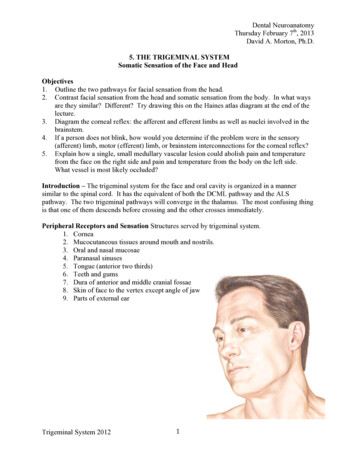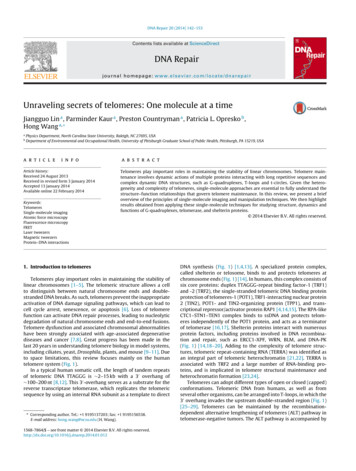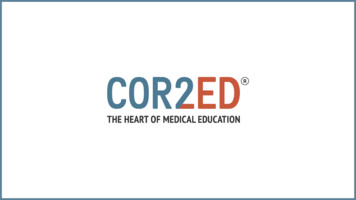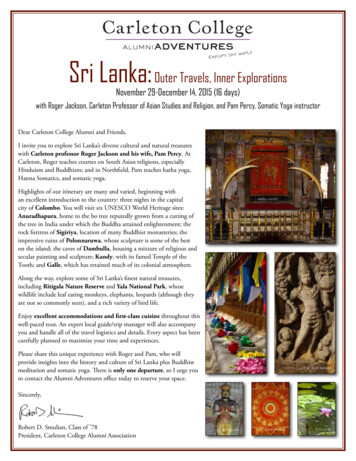
Transcription
Dental NeuroanatomyThursday February 7th, 2013David A. Morton, Ph.D.5. THE TRIGEMINAL SYSTEMSomatic Sensation of the Face and HeadObjectives1. Outline the two pathways for facial sensation from the head.2. Contrast facial sensation from the head and somatic sensation from the body. In what waysare they similar? Different? Try drawing this on the Haines atlas diagram at the end of thelecture.3. Diagram the corneal reflex: the afferent and efferent limbs as well as nuclei involved in thebrainstem.4. If a person does not blink, how would you determine if the problem were in the sensory(afferent) limb, motor (efferent) limb, or brainstem interconnections for the corneal reflex?5. Explain how a single, small medullary vascular lesion could abolish pain and temperaturefrom the face on the right side and pain and temperature from the body on the left side.What vessel is most likely occluded?Introduction – The trigeminal system for the face and oral cavity is organized in a mannersimilar to the spinal cord. It has the equivalent of both the DCML pathway and the ALSpathway. The two trigeminal pathways will converge in the thalamus. The most confusing thingis that one of them descends before crossing and the other crosses immediately.Peripheral Receptors and Sensation Structures served by trigeminal system.1. Cornea2. Mucocutaneous tissues around mouth and nostrils.3. Oral and nasal mucosae4. Paranasal sinuses5. Tongue (anterior two thirds)6. Teeth and gums7. Dura of anterior and middle cranial fossae8. Skin of face to the vertex except angle of jaw9. Parts of external earTrigeminal System 20121
How many neurons in sensory pathway?ALS/DCMLTrigeminal system1. Peripheral ganglion (DRG)1. Peripheral ganglion (Trigeminal ganglion)2. Spinal cord, medulla2. Brainstem (pons, medulla, spinal cord)3. VPL nucleus (thalamus)3. VPM nucleus (thalamus)Primary Sensory Neurons: Trigeminal ganglionA.Trigeminal (semilunar) ganglion.1. Unipolar neurons similar to dorsal root ganglion cells2. Three nerve roots give rise to:a.Ophthalmic nerve, (CN V-1)b.Maxillary nerve, (CN V-2)c.Mandibular nerve, (CN V-3)3. Peripheral distribution of three branches. Back of head and the angle of thejaw are not supplied by the trigeminal (Areas around ear supplied by CNsVII, IX, and X also use this pathway but we will not discuss or test on this.)Trigeminal System 20122
Second-Order Trigeminal Neurons. Originate in two brain stem nuclei.A. Principal (chief) trigeminal nucleus. Mediates fine touch stimuli (two pointdiscrimination), joint position, and vibration. Located in the middle of pons justlateral to the motor nucleus of CN V.This would be equivalent to what nucleus in the brain stem?Young, Young and Tolbert, 2008 Fig 11-10 Trigeminal System 20123
B. Spinal (descending) trigeminal nucleus. Mediates pain and temperature.This nucleus would be the equivalent to what region in the spinal cord?1. Spinal (descending) trigeminal tract contains primary afferents that willsynapse in spinal nucleus of V. The tract is continuous with the dorsolateralfasciculus (Lissauer’s tract) in the spinal cord, again emphasizing thesimilarities with the ALS system.2. The Spinal (descending) nucleus extends caudally as far as C2-C3 and iscontinuous with the dorsal horn. This means it is several cm long.Trigeminal System 20124
C.Ascending Trigeminal Pathways. Axons of second order neurons form thetrigeminothalamic pathway to the VPM (ventroposteromedial) nucleus of thethalamus.The trigeminothalamic pathway is located near the medial lemniscus. Axons fromthe spinal trigeminal nucleus are also referred to as the (ventral) trigeminothalamictract and fibers coming from the principal trigeminal nucleus join it in mid pons.There is a dorsal trigeminothalamic tract we will ignore. We will use the termtrigeminothalamic. These are not tracts you can identify, but vascular lesions caninvolve them.a.Axons from neurons in the chief sensory nucleus carry sensations such as:b.Axons from neurons in the spinal trigeminal nucleus carry sensations such as:Trigeminal System 20125
Third Order Neurons in Thalamus Project to Postcentral Gyrus (Primary sensory cortex).VPM projects somatotopically to the face areas of the cortex via the internal capsule.The face is represented in primary, secondary, and association cortex (superior parietalcortex) just as the projections from VPL.Primary Somatosensory Cortex, Postcentral Gyrus. There are four different body mapsto help extract texture, form, and motion that come from the head and body.INPUT. Internal capsule from VPM (CN V) and VPL (ALS and DCML).INJURY. Postcentral gyrus. Deficits in position sense and ability to discriminate sizes,texture, shape. Pain and temperature are altered but not abolished.Trigeminal System 20126
Trigeminal pathways (Haines)Trigeminal System 20127
Locate the ALS, DCML, Chief trigeminal nucleus or Spinal trigeminal nucleus:PonsMedullaTrigeminal System 20128
Self-assessment: When you think you have mastered the pathways, select 2 colors in both adark and light shade. Use the dark color for the body and the lighter color for the face pathways.e.g.Light blue-Trigeminothalamic (ventral)Dark blue – ALSPink – trigeminothalamic (dorsal) from chiefRed – DCMLTrigeminal System 20129
Dental Neuroanatomy Thursday February 7th, 2013 David A. Morton, Ph.D. 5. THE TRIGEMINAL SYSTEM Somatic Sensation of the Face and Head Objectives 1. Outline the two pathways for facial sensation from the head. 2. Contrast facial sensation from t










